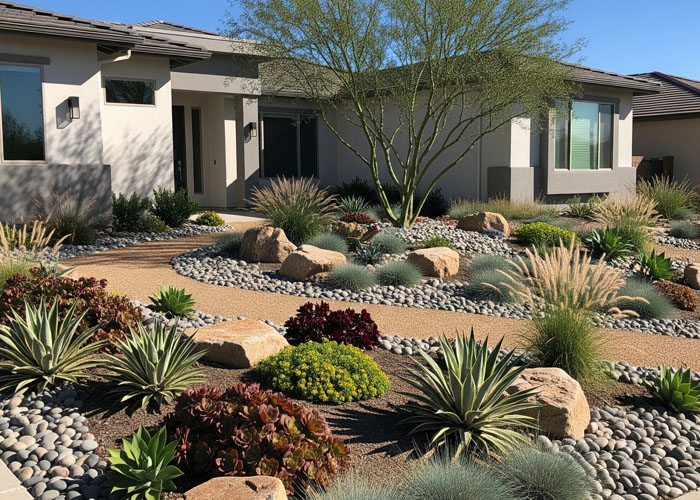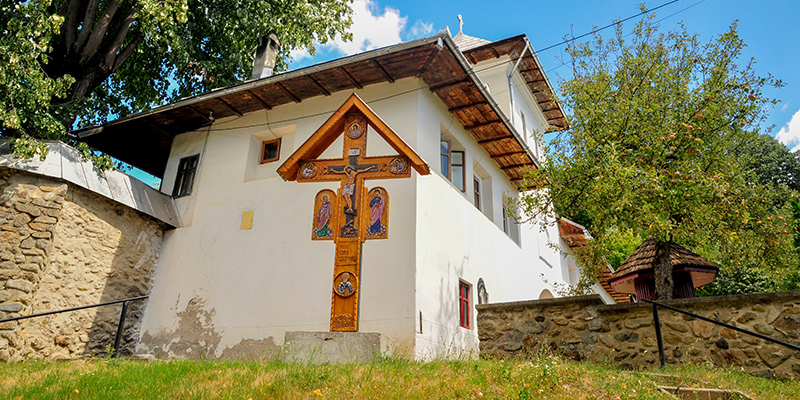HOA Xeriscaping: Is This The New Landscaping Go-To?
Many boards are asking the same question as water costs rise and droughts linger. HOA xeriscaping provides a practical way to reduce outdoor water use while maintaining the community’s attractiveness.
What is HOA Xeriscaping?
HOA xeriscaping is not a yard full of rocks. It is a planned landscape that utilizes climate-adapted plants, smarter irrigation, and ground covers that protect the soil.
Boards like it because it is flexible. You can preserve green space in key areas, then utilize drought-tolerant zones around the edges and in medians. The mix can match your brand, budget, and climate.
Why Xeriscape?

Boards aim to lower costs without compromising curb appeal and property values. HOA xeriscaping achieves both goals by reducing irrigation use and alleviating pressure on operating budgets. Maintenance is steadier too, with fewer mow cycles, lighter fertilizer needs, and simpler repairs keeping common areas tidy.
Native, climate-adapted plants retain their color and texture throughout hot, dry months, while xeriscaping in HOA communities often aligns with local regulations and can qualify for rebates on turf replacement, drip systems, and weather-based controllers. Hydrozoning and smart controllers enhance resilience, enabling landscapes to handle heat waves, watering restrictions, and storms with reduced plant losses.
Principles That Work in Common Areas

Shared spaces typically bear the majority of the watering and maintenance costs. Use the simple principles below to design beds that save water, look clean, and stay easy to care for.
- Plan by hydrozone: Group plants according to their water needs. High-traffic areas are typically located near entrances and signs. Low-use groups fill wide edges, slopes, and corners.
- Fix the soil first: Test the soil, then add compost where needed. Healthy soil holds moisture and nourishes roots, which in turn strengthens new plantings.
- Choose the right plant palette: Favor native or well-adapted species. Think in layers, with tall structure plants, mid-height fillers, and ground covers. Aim for year-round interest.
- Use hardscape and mulch wisely: Paths, boulders, and seating pods can break up wide beds. Organic mulch helps hold water and control weeds.
- Irrigate smarter: Use a drip system for beds and high-efficiency nozzles for your lawn. Add weather-based controllers and flow sensors to stop waste.
- Set a maintenance plan: Even low-water landscapes need care. Plan seasonal checks, pruning, mulch refresh, and drip inspections.
Policy and ARC Guidelines for Xeriscapes
Clear rules make adoption smooth. Establish standards for xeriscaping in HOA design guidelines to inform owners and vendors of the acceptable proposals.
Spell out allowed plant lists, mulch types, rock limits, colors, and edging styles. Define the amount of turf required, if any, and its location. Address defensible space in wildfire-risk areas with set distances and plant spacing.
Getting Homeowner Buy-In
Change is easier when people can see it. Build a small pilot bed near the clubhouse, then share before-and-after photos.
Host a short walkthrough with your landscape contractor so residents can ask questions. Share the watering data and savings a few months after the pilot.
HOA Xeriscaping in Front Yards
Some communities want front yards to match the new style. If so, give owners a template they can follow without guesswork.
Offer a pre-approved option with two or three layouts. Owners can pick a design, choose plants from an approved list, and submit a quick ARC form.
Maintenance Expectations and Vendor Coordination

Low water does not mean no work. Use the checklist below to establish clear expectations with your contractor and maintain consistent performance.
- Drip audits at least twice a year
- Seasonal controller changes based on the weather
- Mulch top-ups to maintain depth
- Targeted weed control that protects beneficial plants
- Pruning guided by plant habit, not by calendar
Common Pitfalls and How to Avoid Them
A few missteps can erase savings and frustrate homeowners. Watch for these issues and plan around them from the start.
- All-rock yards: Large rock fields reflect heat, raise ambient temperatures, and invite weeds. Balance rock with plants and mulch.
- Plastic sheeting: Solid plastic traps water on top and chokes roots. Use breathable weed barriers where needed.
- Wrong mulch choice: Fine mulch can blow away. Select a stable chip size that matches your climate and slope conditions.
- Poor drainage: Xeriscapes still need proper grading and catch basins. Fix drainage before planting.
- Thirsty species: Avoid plants that need constant irrigation or heavy fertilizer. Confirm water needs at the planning stage.
Measuring Results and Reporting Back
Decide how you will track success before work starts. Use the metrics below to show progress to the board and homeowners.
- Water use per irrigated acre
- Gallons saved compared to the prior year
- Cost per square foot to maintain
- Plant survival rates through the first summer and first winter
- Complaints and compliments logged after the change
Practical Steps to Launch

A simple plan keeps the rollout on track and builds trust with residents. Use the steps below as a template, then adjust to your climate, budget, and timeline.
- Audit water and turf: Map leaks, overspray, and high-use zones. Pull the last 12 months of water bills to set a clear baseline.
- Pick pilot areas: Choose spots with high visibility and high water use. Include one sunny bed and one shaded bed to test plant performance.
- Draft standards: Update ARC rules for plant lists, rock limits, mulch types, spacing, and irrigation. Add photo examples to make submittals easy to review.
- Bid the work: Request itemized pricing for removal, soil prep, irrigation retrofit, plants, mulch, and first-year maintenance. Ask vendors to include any rebate-ready specs and paperwork.
- Communicate: Share mockups, a simple timeline, and a one-page homeowner guide. Host a short demo or walkthrough so residents can see the plan up close.
- Measure and share: Track gallons and costs monthly against your baseline. Post a short quarterly dashboard and capture resident feedback for the next phase.
- Train and hand off: Brief the onsite staff and the landscape crew on the standards and seasonal tasks. Schedule 30-day and 90-day walks to fix punch-list items early.
The Case for HOA Xeriscaping
For many boards, HOA xeriscaping is the practical next step. Begin by implementing a pilot, updating ARC standards, and then tracking results to demonstrate savings, reliability, and curb appeal clearly. Done this way, the community gains a landscape that looks good, costs less, and fits the climate.
Looking for efficient management solutions for your HOA community? Condo Manager provides a trusted and reliable community association management platform for self-managed associations and HOA management companies. Reach us online or call us today at (800) 626-1267 to learn more!
Related Articles:






 Detailed Scope of Work
Detailed Scope of Work HOA Access and Oversight Rights
HOA Access and Oversight Rights 4. Interview Finalists
4. Interview Finalists
 Ensuring Quality Services
Ensuring Quality Services 3. Request Proposals
3. Request Proposals Bid Comparisons
Bid Comparisons Document Everything
Document Everything
 One of the biggest advantages of working with local vendors is their proximity. You can usually find them nearby. This lets them respond quickly to emergencies like plumbing leaks, electrical outages, or storm damage. This helps minimize downtime and inconvenience for residents. This accessibility makes them invaluable for time-sensitive issues.
One of the biggest advantages of working with local vendors is their proximity. You can usually find them nearby. This lets them respond quickly to emergencies like plumbing leaks, electrical outages, or storm damage. This helps minimize downtime and inconvenience for residents. This accessibility makes them invaluable for time-sensitive issues. Local vendors are more willing to provide customizable contracts. They are also less likely to impose penalties for early termination or changes in service scope, making them a more adaptable option.
Local vendors are more willing to provide customizable contracts. They are also less likely to impose penalties for early termination or changes in service scope, making them a more adaptable option.

 Bulk Waste Pickup
Bulk Waste Pickup How Does the HOA Handle Recycling?
How Does the HOA Handle Recycling?
 Homeowners associations shouldn’t just send an RFP detailing the project’s scope of work. They should also provide a clear objective for the project. After all, the deliverables and scope of work may change if the project’s overall goals and trajectory change.
Homeowners associations shouldn’t just send an RFP detailing the project’s scope of work. They should also provide a clear objective for the project. After all, the deliverables and scope of work may change if the project’s overall goals and trajectory change. HOA vendors need to know what the application process is like. In this section, tell the vendor where and when they must submit the proposal. It may also include any next steps they can expect from the HOA after receiving the bid.
HOA vendors need to know what the application process is like. In this section, tell the vendor where and when they must submit the proposal. It may also include any next steps they can expect from the HOA after receiving the bid.
 Does the HOA cover plumbing? The HOA is likely responsible for repairing plumbing systems in the common areas. Moreover, the board should conduct periodic inspections and regular maintenance activities on the plumbing system.
Does the HOA cover plumbing? The HOA is likely responsible for repairing plumbing systems in the common areas. Moreover, the board should conduct periodic inspections and regular maintenance activities on the plumbing system. HOA plumbing issues can be tricky to navigate as most pipelines run through the entire community. It’s even harder when some pipes only serve a few residences and not others. Both homeowners and board members must review the governing documents to understand their scope of responsibility.
HOA plumbing issues can be tricky to navigate as most pipelines run through the entire community. It’s even harder when some pipes only serve a few residences and not others. Both homeowners and board members must review the governing documents to understand their scope of responsibility.
 Access Control. Security guards may guard entry points to ensure only those authorized can enter the community.
Access Control. Security guards may guard entry points to ensure only those authorized can enter the community. While an HOA security patrol is undoubtedly useful, it can also be costly. This is especially true for large communities with multiple entry points. However, just because a community cannot afford security guards does not mean they should give up on enhancing safety and security.
While an HOA security patrol is undoubtedly useful, it can also be costly. This is especially true for large communities with multiple entry points. However, just because a community cannot afford security guards does not mean they should give up on enhancing safety and security.
